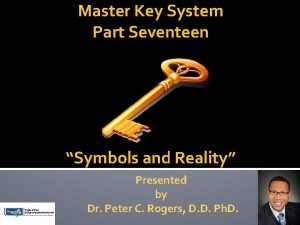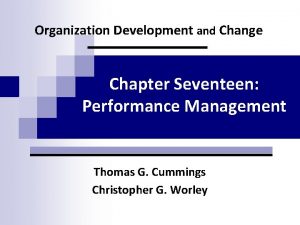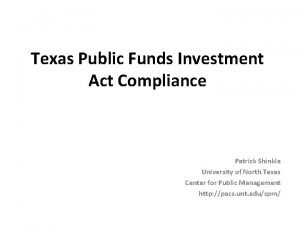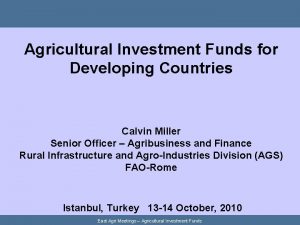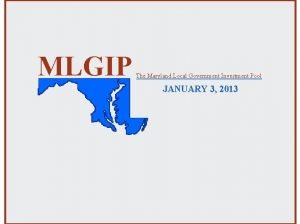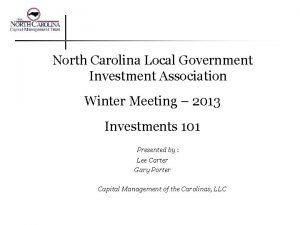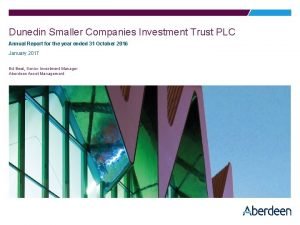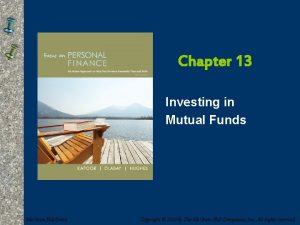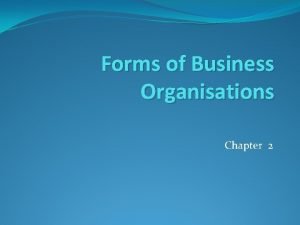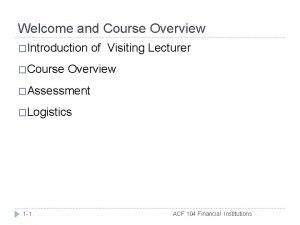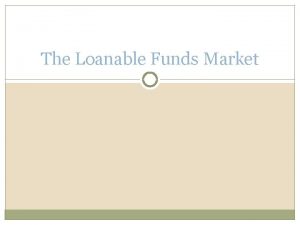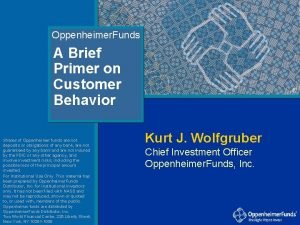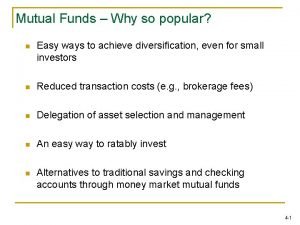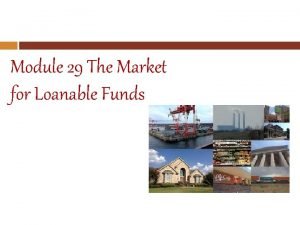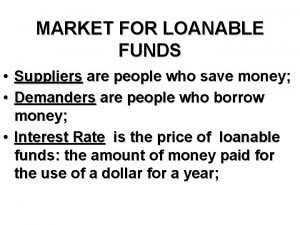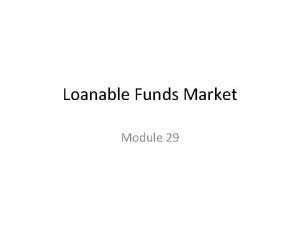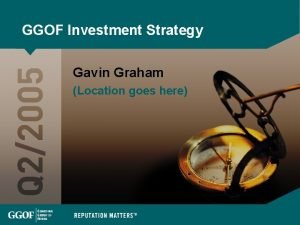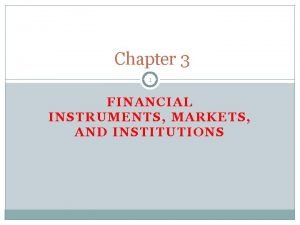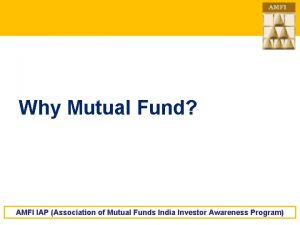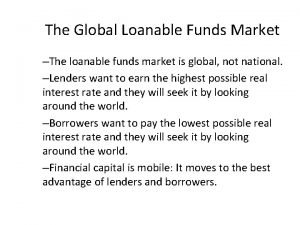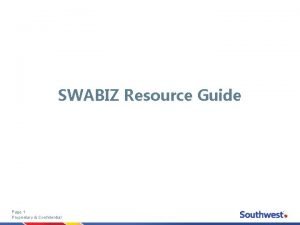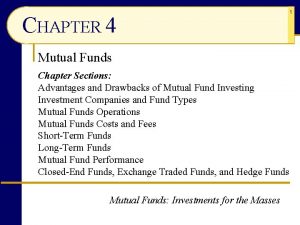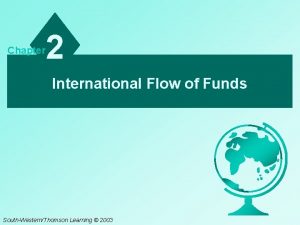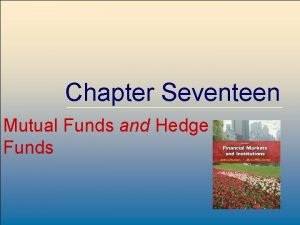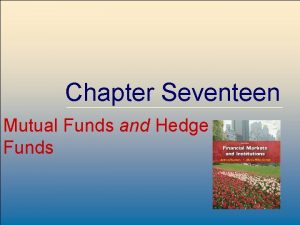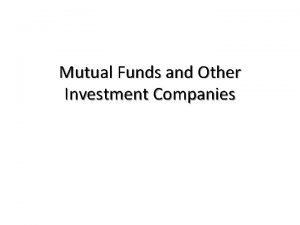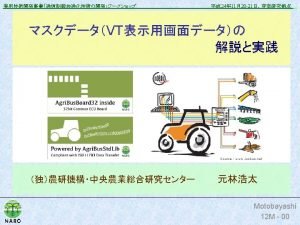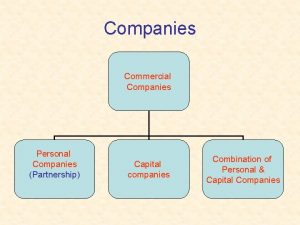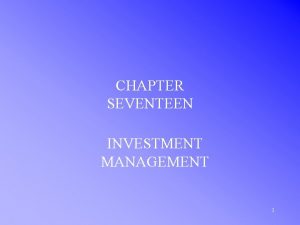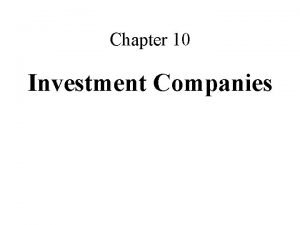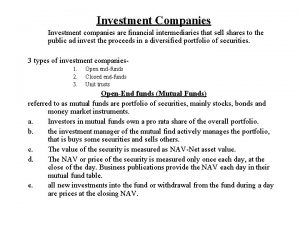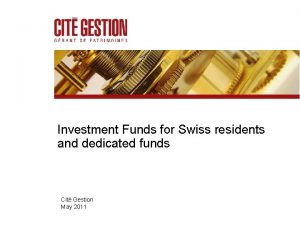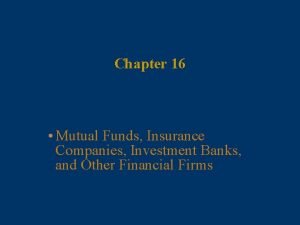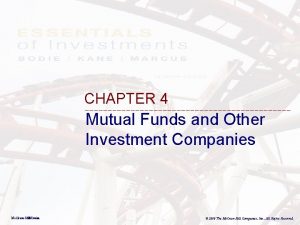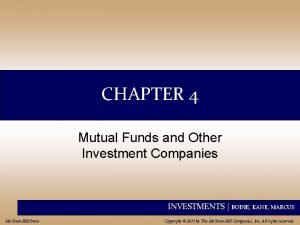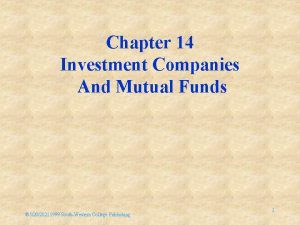Chapter Seventeen Investment Companies Investment Companies Pool funds







































- Slides: 39

Chapter Seventeen Investment Companies

Investment Companies • Pool funds of individual investors and invest in a wide range of securities or other assets • Services provided: • Record keeping and administration • Diversification and divisibility • Professional management • Lower transaction costs

Pros and Cons

Mutual Funds l Investment companies have a favorable tax situation l l Pay no federal taxes on income generated by their security holdings But only if their earnings flow through to their customers 16 -4

Taxes TAXES AND MUTUAL FUNDS l Income dividends are reported on your federal tax return l Capital gain distributions are taxed as long term capital gains regardless of how long you own shares in the mutual fund l Capital gains or losses, when selling the shares are taxed on short-term or long-term basis depending on the length of time the funds are held l Funds reinvested in the purchase of additional shares are still taxable l The “turnover ratio” of a fund affects your tax liability 5

Net Asset Value l Net Asset Value (NAV) is the value of each share in the investment company l Calculation: Market Value of Assets - Liabilities Shares Outstanding

Types of Investment Companies • Unit Trusts • Fixed portfolio of uniform assets • Unmanaged • Total assets have declined from $105 billion in 1990 to $60 billion in 2012

Types of Investment Companies • Managed Investment Companies • • Open-End • Fund issues new shares when investors buy in and redeems shares when investors cash out • Priced at Net Asset Value (NAV) Closed-End • No change in shares outstanding; old investors cash out by selling to new investors • Priced at premium or discount to NAV

Investment Companies l Open-end mutual funds sell new shares to investors and redeem outstanding shares on demand at their fair market values l l l The first MF was established in Boston in 1924 By 1970, 361 MFs held about $50 billion in assets Hedge funds (HFs) are a type of investment pool that solicits funds from (wealthy) individuals and other investors (e. g. , commercial banks) and invests these funds on their behalf Money market mutual funds (MMMFs) were introduced in 1972 Tax-exempt MMMFs were introduced in 1979 By 2016, 8, 105 MFs held over $16 trillion in assets © 2019 Mc. Graw-Hill Education. All rights reserved. Authorized only for instructor use in the classroom. No reproduction or further distribution permitted without the prior written consent of Mc. Graw-Hill Education.

Other Types of Investment Company Funds l An open-end MF is a fund for which the supply of shares is not fixed, but can increase or decrease daily with purchases and redemptions of shares l l A closed-end investment company is a specialized investment company that has a fixed supply of outstanding shares, but invests in the securities and assets of other firms l l In 2016, there were $16, 350 billion invested in 8, 105 open-end mutual funds In 2016, there were $265 billion invested in 545 closed-end funds A unit investment trust, such as a real estate investment trust, is a fund that sells a fixed number of redeemable shares that are redeemed on a set termination date l In 2016, there was about $74. 25 billion invested in over 5, 188 UITs © 2019 Mc. Graw-Hill Education. All rights reserved. Authorized only for instructor use in the classroom. No reproduction or further distribution permitted without the prior written consent of Mc. Graw-Hill Education.

Mutual Fund Types l l Unit Investment Trusts Are portfolios that are assembled by a packager, usually a brokerage house. They are mostly bond funds, sold for income, but can be stock funds. There is no secondary market. l The issuer will usually buy them back from the investor

Costs LOAD FUNDS AND NO-LOAD FUNDS l Load Fund l Investors pay a commission (sales charge) up to 8. 5% every time they purchase shares. This is sometimes called a front load. (Class A shares) l Average charge is 3 -5% for which an investor can get purchase advice and explanations. l No-Load Fund l Investors pay no sales charge up front. l You deal directly with the fund with 800 numbers or websites or from discount brokers. 16 -12

Costs LOAD FUNDS AND NO-LOAD FUNDS l Contingent deferred sales load (back-end load) (Class B shares) l Charged upon withdrawal of funds (1 -5%) l Generally decreases on a sliding scale depending on the number of years shares are held 16 -13

Costs MANAGEMENT FEES AND OTHER CHARGES l Management fee l Charged yearly (0. 5%-1% average) based on a percentage of the funds asset value l 12 b-1 fees (Class C shares) l Annual fee to defray distribution and marketing costs of the fund l Cannot exceed 1% of a fund’s assets per year 16 -14

Costs MANAGEMENT FEES AND OTHER CHARGES (continued) l Expense Ratio consists of the different management fees and additional fund operating costs for a specific mutual fund: this fee should not exceed 1 percent 16 -15

Costs of Investing in Mutual Funds l l Fee Structure: 1. Operating expenses 2. Front-end load 3. Back-end load 4. 12 b-1 charge Fees must be disclosed in the prospectus l Share classes with different fee combinations

Example 4. 2: Fees for Various Classes

Mutual Fund Industry l Cash flows into MFs are highly correlated with the return on stock markets l Growth has also resulted from the rise in retirement funds under management by MFs l l MFs manage ~ 25% of retirement fund assets MFs are the second most important group of FIs as measured by asset size; second only to depository institutions l l Banks’ share of all MF assets was 5% in 2016 Insurance companies managed 5% of MF industry assets in 2016 © 2019 Mc. Graw-Hill Education. All rights reserved. Authorized only for instructor use in the classroom. No reproduction or further distribution permitted without the prior written consent of Mc. Graw-Hill Education.

Mutual Fund Industry Continued l l In September 2008, the Primary Reserve Fund - a money market mutual fund - ‘broke the buck’ and had its share value fall below the standard $1 due to losses on $785 million of commercial paper issued by Lehman brothers This led to contagion and a run on money funds with over $200 billion outflows over the next few days The Treasury guaranteed payments on money funds for one year to stop the runs. The insurance ran out September 19, 2009. New rules proposed by the SEC mandate money fund shares fluctuate with value of fund holdings to prevent runs © 2019 Mc. Graw-Hill Education. All rights reserved. Authorized only for instructor use in the classroom. No reproduction or further distribution permitted without the prior written consent of Mc. Graw-Hill Education.

Mutual Fund Industry Concluded l The barriers to entry in the MF industry are low l The largest MF sponsors have not increased their market share recently l l The largest 25 companies that sponsor mutual funds managed 75% of industry assets in 2016, just slightly larger than 1995 However, the composition of the top 25 fund sponsors in the industry has changed l 15 of the largest fund companies in 2016 were not among the largest in 1990 © 2019 Mc. Graw-Hill Education. All rights reserved. Authorized only for instructor use in the classroom. No reproduction or further distribution permitted without the prior written consent of Mc. Graw-Hill Education.

Mutual Funds • How Funds Are Sold • Direct-marketed funds • Sales-force distributed • • Revenue sharing on sales force distributed • Potential conflicts of interest Financial supermarkets

Types of Mutual Funds l The MF industry has two sectors l Short-term funds invest in securities with original maturities of less than one year l l l Money market mutual funds (MMMFs) are funds consisting of various mixtures of money market securities Tax-exempt money market mutual funds contain various mixed of those money market securities with an original maturity of less than one year Long-term funds invest in portfolios of securities with original maturities of more than one year l l l Equity funds consist of common and preferred stock Bond funds consist of fixed-income capital market debt securities Hybrid funds consist of both stock and bond securities © 2019 Mc. Graw-Hill Education. All rights reserved. Authorized only for instructor use in the classroom. No reproduction or further distribution permitted without the prior written consent of Mc. Graw-Hill Education.

Classification of Mutual Funds FAMILY OF FUNDS l A family of funds exists when one investment company manages a group of mutual funds l Each fund in the family has a different financial objective l Exchange privileges allow you to move your money from one fund to another within the fund family with little or no charge 23

Types of Mutual Funds Concluded l Money market mutual funds (MMMFs) provide an alternative investment to interest-bearing deposits at commercial banks l Bank deposits are relatively less risky, because they are FDIC insured, and generally offer lower returns than MMMFs l Households own the majority of MFs l Owned 57. 4% of long-term funds in 2013 l Owned 38. 4% of short-term funds in 2013 l 44. 4% of all U. S. households owned MFs in 2016—which represents ~55. 9 million households l Typical owner has $94, 300 invested in four funds © 2019 Mc. Graw-Hill Education. All rights reserved. Authorized only for instructor use in the classroom. No reproduction or further distribution permitted without the prior written consent of Mc. Graw-Hill Education.

Mutual Fund Prospectus and Objectives l MF managers must specify their fund’s investment objectives in a prospectus (a formal summary of a proposed investment), which is made available to potential investors l l l Holds lists of the securities invested in by the funds In 1998, the Securities and Exchange Commission (SEC) mandated that prospectuses must be written in “plain English” instead of overly legal language No investor should invest in a fund without carefully reading the prospectus The prospectus will contain historical return information, usually for 1 -year, 3 -year and 5 -year periods and perhaps longer The prospectus must also show historical fees and the effect of those fees on a given investment over time Little information on risk is usually provided © 2019 Mc. Graw-Hill Education. All rights reserved. Authorized only for instructor use in the classroom. No reproduction or further distribution permitted without the prior written consent of Mc. Graw-Hill Education.

Index Funds and Exchange Traded Funds (ETFs) l In 2016, there were 406 index funds managing $2. 2 trillion l l l Index funds are funds in which managers buy securities in proportions similar to those included in a specified major index Index funds involve little research or management, which results in lower management fees and higher returns than actively managed funds Exchange traded funds (ETFs) are long-term mutual funds that are also designed to replicate a particular stock market index l l l Traded on exchanges at prices determined by the market Management fees are lower than actively traded funds Unlike index funds, ETFs can be traded during the day, sold short, and purchased on margin © 2019 Mc. Graw-Hill Education. All rights reserved. Authorized only for instructor use in the classroom. No reproduction or further distribution permitted without the prior written consent of Mc. Graw-Hill Education.

Investor Returns from Mutual Fund Ownership l Investor returns from MF ownership reflect three components l l MF assets are marked to market daily l l Income and dividends on portfolio assets Capital gains on assets bought and sold at higher prices Capital appreciation on assets held in the fund Managers of the fund calculate the current value of each mutual fund share by computing the daily market value of the fund’s total asset portfolio less any liabilities and then dividing this amount by the number of mutual fund shares outstanding The net asset value (NAV) of a MF share is equal to the market value of the assets in the MF portfolio divided by the number of shares outstanding © 2019 Mc. Graw-Hill Education. All rights reserved. Authorized only for instructor use in the classroom. No reproduction or further distribution permitted without the prior written consent of Mc. Graw-Hill Education.

Mutual Fund Costs l MFs charge investors fees for the services they provide l l l Sales loads (front end or back end) 12 b-1 fees are fees related to the distribution costs of MF shares l Marking and distribution expenses cannot exceed 0. 75% of a fund’s average net assets per year l FINRAvalso imposes an annual cap of 0. 25% on shareholder service fees MFs may offer different share classes with different combinations of loads A load fund is an MF with an up-front sales or commission charge that the investor must pay A no-load fund is an MF that does not charge up-front sales or commission charges on the sale of mutual fund shares to investors © 2019 Mc. Graw-Hill Education. All rights reserved. Authorized only for instructor use in the classroom. No reproduction or further distribution permitted without the prior written consent of Mc. Graw-Hill Education.

Largest Mutual Funds in Assets Managed © 2019 Mc. Graw-Hill Education. All rights reserved. Authorized only for instructor use in the classroom. No reproduction or further distribution permitted without the prior written consent of Mc. Graw-Hill Education.

Example This year an investor placed $10, 000 in a mutual fund with a 6% load (one time fee) and estimated annual expenses of 1. 35%. Fees are charged against average assets for the year. The fund’s gross return is 11. 5%. What was the investor’s first year return net of loads and expenses? Amount initially invested Amount after gross return Average asset value for year Fees Ending amount after fees Net rate of return (first year) = $10, 000 – (0. 06 $10, 000) = $9, 400 1. 115 = $10, 481 = ($10, 481 + $9, 400) / 2 = $9, 940. 50 * 0. 0135 = $134. 20 = $10, 481 - $134. 20 = $10, 346. 80 = ($10, 346. 80 / $10, 000) – 1 = 3. 47% © 2019 Mc. Graw-Hill Education. All rights reserved. Authorized only for instructor use in the classroom. No reproduction or further distribution permitted without the prior written consent of Mc. Graw-Hill Education.

Mutual Fund Regulation l MFs are heavily regulated because they manage and invest small investor savings l The SEC is the primary regulator l l l The Securities Act of 1933 The Securities Exchange Act of 1934 The Investment Advisers Act and Investment Company Act of 1940 The Insider Trading and Securities Fraud Enforcement Act of 1988 The Market Reform Act of 1990 The National Securities Market Improvement Act (NSMIA) of 1996 © 2019 Mc. Graw-Hill Education. All rights reserved. Authorized only for instructor use in the classroom. No reproduction or further distribution permitted without the prior written consent of Mc. Graw-Hill Education.

Investor Abuses l Even with heavy regulation, investor abuses still occur l l Market timing is short-term trading of mutual funds that seeks to take advantage of short-term discrepancies between the price of a mutual fund’s shares and out-ofdate values on the securities in the fund’s portfolio Late trading involves buys and sells long after prices have been set at 4: 00 pm E. T. Directed brokerage occurs when brokers improperly influence investors on their fund recommendations Improperly assessed fees occur when brokers trick customers into thinking they are buying no-load funds or fail to provide discounts properly © 2019 Mc. Graw-Hill Education. All rights reserved. Authorized only for instructor use in the classroom. No reproduction or further distribution permitted without the prior written consent of Mc. Graw-Hill Education.

Hedge Funds l Hedge funds (HFs) are investment pools that solicit funds from wealthy individuals and other investors (e. g. , commercial banks) and invest these funds on their behalf l l Similar to MFs, but smaller funds under $100 million in assets are not required to register with the SEC Subject to less regulatory oversight than mutual funds and generally can (and do) take significantly more risk than MFs Do not have to publicly disclose their activities to third parties and thus offer a high degree of privacy HFs avoid regulation by limiting the number of investors to less than 100 and by requiring investors to be “accredited” l Accredited investors have net worth over $1 million or annual income over $200, 000 if single (or $300, 000 if married) © 2019 Mc. Graw-Hill Education. All rights reserved. Authorized only for instructor use in the classroom. No reproduction or further distribution permitted without the prior written consent of Mc. Graw-Hill Education.

Hedge Funds Continued l HFs use more aggressive trading strategies than MFs, such as short selling, leveraging, program trading, arbitrage, and the use of derivatives l Because not all HFs are registered, industry and firm data cannot be accurately tracked (i. e. , the data is self-reported) ~ 10, 000 HFs in the U. S. in 2013 ~ $2. 98 trillion in assets in 2016 © 2019 Mc. Graw-Hill Education. All rights reserved. Authorized only for instructor use in the classroom. No reproduction or further distribution permitted without the prior written consent of Mc. Graw-Hill Education.

Types of Hedge Funds © 2019 Mc. Graw-Hill Education. All rights reserved. Authorized only for instructor use in the classroom. No reproduction or further distribution permitted without the prior written consent of Mc. Graw-Hill Education.

Fees on Hedge Funds l Management fees on HFs are computed as a percent of total assets under management and run between 1. 5% and 2% l Performance fees give fund managers a share of any positive returns on a hedge fund l l The average is 20%, but performance fees vary substantially depending on the HF A hurdle rate is a benchmark that must be realized before a performance fee can be assessed A high-water mark is when a manager does not receive a performance fee unless the value of the fund exceeds the highest NAV it has previously achieved Offshore HFs are attractive to investors because they provide anonymity and are not subject to U. S. taxes © 2019 Mc. Graw-Hill Education. All rights reserved. Authorized only for instructor use in the classroom. No reproduction or further distribution permitted without the prior written consent of Mc. Graw-Hill Education.

Regulation of Hedge Funds l While mutual funds are very highly regulated, hedge funds have generally been unregulated l l Hedge funds operate under two exemptions from registration requirements as set forth in the Investment Company Act of 1940 l l l Mutual funds in the U. S. are required to be registered with the SEC Funds are exempt if they have less than 100 investors Funds are exempt if the investors are “accredited” Hedge funds are only sold via private placements, and may not be offered or advertised to the general investing public © 2019 Mc. Graw-Hill Education. All rights reserved. Authorized only for instructor use in the classroom. No reproduction or further distribution permitted without the prior written consent of Mc. Graw-Hill Education.

Top Hedge Funds by Fund Earnings, 2008 -2009 © 2019 Mc. Graw-Hill Education. All rights reserved. Authorized only for instructor use in the classroom. No reproduction or further distribution permitted without the prior written consent of Mc. Graw-Hill Education.

High Profile Hedge Funds Problems l The collapse of the two Bear Stearns hedge funds led to investor losses of $1. 6 billion and led to the bankruptcy of the company l Bernard Madoff Investment Securities run by former NASDAQ chairman Bernie Madoff ran a $65 billion Ponzi scheme l In October 2009, a large hedge fund, Galleon Group LLC, was closed due to an insider trading scandal l In July 2013, SAC Capital was charged with pervasive violations of inside trading laws © 2019 Mc. Graw-Hill Education. All rights reserved. Authorized only for instructor use in the classroom. No reproduction or further distribution permitted without the prior written consent of Mc. Graw-Hill Education.
 Dance moms seventeen magazine
Dance moms seventeen magazine Seventeen symbols
Seventeen symbols Seventeen current manager
Seventeen current manager Seventeen table
Seventeen table Public funds investment act training
Public funds investment act training Agricultural investment funds for developing countries
Agricultural investment funds for developing countries Mlgip
Mlgip Local government investment pool services north carolina
Local government investment pool services north carolina Local government investment pool services north carolilna
Local government investment pool services north carolilna Dunedin smaller companies investment trust
Dunedin smaller companies investment trust Fixed investment and inventory investment
Fixed investment and inventory investment Chapter 13 investing in mutual funds
Chapter 13 investing in mutual funds Alice in wonderland pool of tears
Alice in wonderland pool of tears Particular partnership
Particular partnership Sources and uses of funds
Sources and uses of funds Financial intermediaries
Financial intermediaries Funds flow model
Funds flow model Loanable funds shifters
Loanable funds shifters Shareholders equity and shareholders funds
Shareholders equity and shareholders funds Funds from operations
Funds from operations Oppenheimer funds customer service
Oppenheimer funds customer service Mutual funds examples
Mutual funds examples Loanable funds shifters
Loanable funds shifters Who are the suppliers of loanable funds
Who are the suppliers of loanable funds Loanable funds market
Loanable funds market Shifters of the loanable funds graph
Shifters of the loanable funds graph Ggof funds
Ggof funds Analysis of fund flow statement
Analysis of fund flow statement Prime funds calgary
Prime funds calgary Deped order 8 s 2007
Deped order 8 s 2007 Financial markets instruments and institutions
Financial markets instruments and institutions Six reasons why a bank may dishonor a check
Six reasons why a bank may dishonor a check Iap mutual funds
Iap mutual funds Loanable funds nedir
Loanable funds nedir Swabiz.com login
Swabiz.com login Contractionary monetary policies
Contractionary monetary policies Hartford funds media replay
Hartford funds media replay Advantages and disadvantages of closed end funds
Advantages and disadvantages of closed end funds Agencies that facilitate international flow of funds
Agencies that facilitate international flow of funds Mutual funds disclaimer
Mutual funds disclaimer

